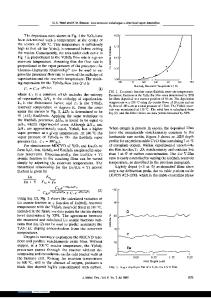Characterization of (Ba, Sr)RuO 3 Films Deposited by Metal-organic Chemical Vapor Deposition
- PDF / 332,890 Bytes
- 6 Pages / 612 x 792 pts (letter) Page_size
- 72 Downloads / 332 Views
Characterization of (Ba,Sr)RuO3 Films Deposited by Metal-organic Chemical Vapor Deposition
Duck-Kyun Choi, Joong-Seo Kang, Young-Bae Kim, Duck-Hwa Hong, Hyun-Chul Kim, Sung-Tae Kim1 and Cha-Young Yoo1 Department of Ceramic Engineering, Hanyang University Seoul 133-791, Korea 1 Semiconductor R&D Division, Samsung Electronics Company
ABSTRACT
Thin film electrodes of the perovskite oxide (Ba,Sr)RuO3 (BSR) were deposited on 4 inch ptype Si wafers by metal organic chemical vapor deposition (MOCVD) for the practical (Ba,Sr)TiO3 (BST) capacitor application using a new single cocktail source. The source materials used for the MOCVD BSR process were Ba(METHD)2, Sr(METHD)2 and Ru(METHD)3 and these were dissolved in n-butyl acetate. The source-feeding rate was precisely controlled by liquid mass flow controllers (LMFC). As-deposited BSR films possessed a (110)-oriented structure, with good uniformity and adherence on bare Si wafer. The phase formation was strongly affected by the oxygen flow rate and the input source rate. As the oxygen flow rate increased, the Ru/(Ba+Sr) composition ratio in the film decreased, while the Ba/(Ba+Sr) ratio was almost independent of the oxygen flow rate. The dielectric constants of BST capacitors fabricated using these electrodes was greater than 500.
INTRODUCTION
(Ba,Sr)TiO3 (BST) thin films have been widely investigated as the dielectric material for future DRAM storage capacitors due to their high dielectric constant [1]. The selection of the electrode material is very difficult because the electrical characteristics of BST capacitors are strongly affected by the electrode material and a high temperature process in an oxygen atmosphere is required during the deposition or crystallization of BST films. Pt electrodes have been the most widely applied electrode for BST capacitors owing to the fact that they provide the best electrical properties among the possible electrode materials. But poor etchability and adhesion have been reported as major obstacles in the use of Pt as a BST electrode [2,3]. The RuO2 conductive oxide material has been tested as an alternative to Pt because of its excellent etching properties and oxygen diffusion barrier characteristics [3]. However, the leakage current of BST on RuO2 electrodes is relatively high for practical applications and the electrical properties of the BST films have been found to degrade drastically as the BST film thickness decreases [4,5]. Recently, several conducting perovskite oxides, such as SrRuO3, BaRuO3 and (Ca,Ru)O3, which can satisfy most requirements, have also been studied as electrodes for BST films [6-8]. Previously, we proposed the (Ba,Sr)RuO3 perovskite oxide electrode deposited by the sputtering method, because it demonstrated good interfacial properties due to its outstanding C4.25.1
structural match and chemical compatibility with BST (local epitaxial growth of BST and no low dielectric interfacial layer) [9-11]. In this work, BSR films were deposited by MOCVD because this technique offers superior step coverage, an import
Data Loading...











